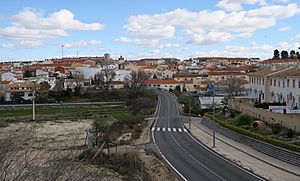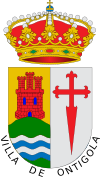Ontígola facts for kids
Quick facts for kids
Ontígola
|
|||
|---|---|---|---|
 |
|||
|
|||
 |
|||
| Country | |||
| Autonomous community | |||
| Province | Toledo | ||
| Comarca | Mesa de Ocaña | ||
| Judicial district | Ocaña | ||
| Area | |||
| • Total | 41.49 km2 (16.02 sq mi) | ||
| Elevation | 602 m (1,975 ft) | ||
| Population
(2018)
|
|||
| • Total | 4,279 | ||
| • Density | 103.133/km2 (267.11/sq mi) | ||
| Demonym(s) | Ontigoleño, ña Orejano, na Aurelanense, sa | ||
| Time zone | UTC+1 (CET) | ||
| • Summer (DST) | UTC+2 (CEST) | ||
| Postal code |
45340
|
||
| Dialing code | 925 | ||
Ontígola is a cool town, or municipality, found in the province of Toledo, in the region of Castile-La Mancha, Spain. It's a place with a rich history! In 2023, about 4,926 people lived there, according to official numbers.
Contents
Discovering Ontígola's Name
The name "Ontígola" comes from an old Latin word, FŎNTĬCŬLA. This word means "fountain" or "a spring of water that comes out of the ground." So, the town's name is linked to water! Over time, the name changed a bit. You might see it written as Fonticulam, Fontigula, Antigola, or Hontigola in old books.
Ancient History of Ontígola
The Roman Town of Aurelia
Near Ontígola, there was once an ancient Roman town called Aurelia. Today, it's an uninhabited area known as Oreja. This old town was very important a long time ago.
Oreja's Role in History
Oreja played a key part in the defense of the Tagus River during the 11th and 12th centuries. It was a strong point for the Islamic defensive line in that area.
The Battle of Ontígola
A Clash During the War
On November 18, 1809, a battle took place near Ontígola during the War of Independence. Spanish troops, led by General Juan Carlos de Aréizaga, fought against French forces.
Key Moments of the Battle
The French army pushed back the Spanish troops in this clash. A notable event was the death of French General Paris. He was killed by a Spanish soldier named Cape Vincent Manzano. On the Spanish side, Angel Saavedra, who was the Duke of Rivas, also died.
The End of the Day
Writers Nicomedes Pastor Diaz and Francisco de Cardenas described the end of the battle. They wrote that the night was "sad and black." The Spanish soldiers retreated in confusion to Ocaña. The main French army and their general stayed in Antígola, leaving the battlefield covered with bodies.
See also
 In Spanish: Ontígola para niños
In Spanish: Ontígola para niños




